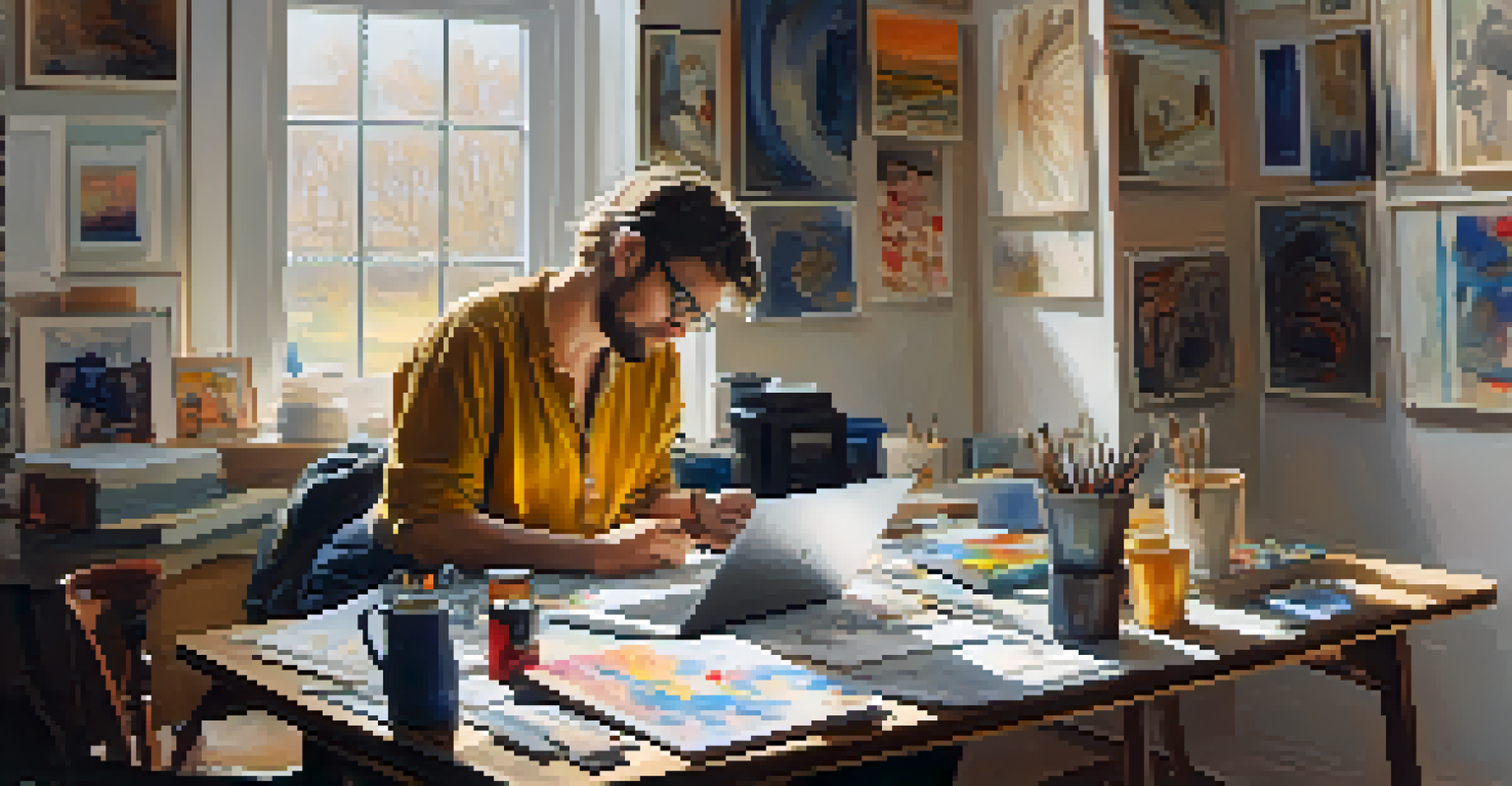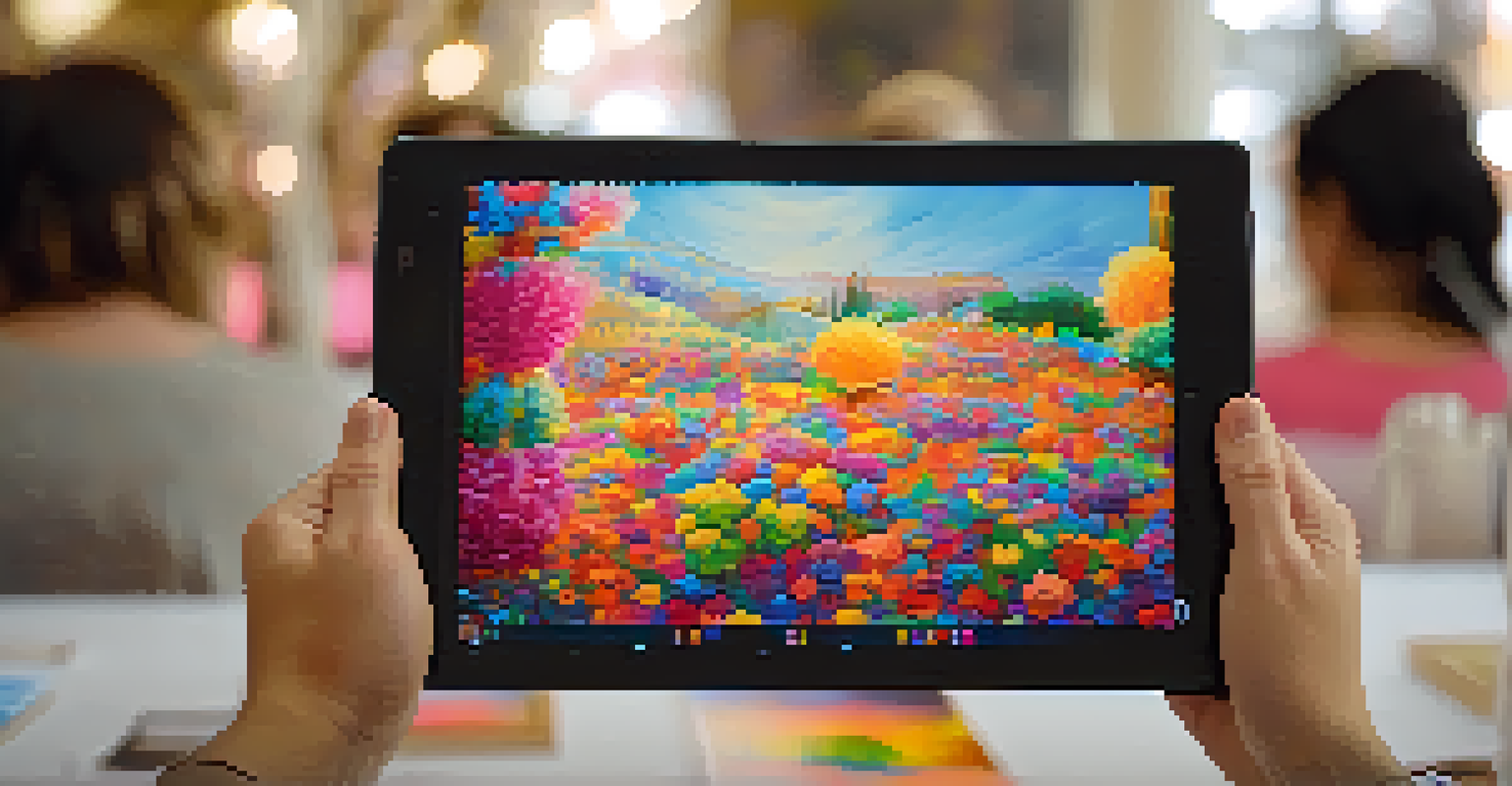Online Art Auctions: Revolutionizing Art Sales Worldwide

The Emergence of Online Art Auctions
Online art auctions have dramatically changed how art is bought and sold. Traditionally, art sales took place in exclusive galleries or auction houses, which could limit access for many potential buyers. With the rise of digital platforms, art enthusiasts from around the globe can now join in on auctions from the comfort of their homes.
Art is not what you see, but what you make others see.
This shift has not only broadened the audience but has also democratized the art-buying process. No longer do you need to be part of an elite circle to acquire stunning pieces. Online platforms have made it easier for emerging artists to showcase their work and for collectors to discover fresh talent.
As technology continues to evolve, these online auctions are becoming increasingly sophisticated. Features like live streaming and virtual reality previews make the experience more immersive, allowing buyers to feel connected to the art, even when they’re miles away.
Accessibility for Artists and Collectors
One of the most significant advantages of online art auctions is the accessibility they provide. Artists can reach a global audience without the need for physical exhibitions, which often come with high costs. This means that even lesser-known artists have a chance to gain visibility and sell their work.

For collectors, this accessibility translates to a wider range of options. Rather than being confined to local galleries, they can explore diverse styles and mediums from artists around the world. This variety can inspire collectors to branch out and invest in unique pieces they might not have encountered otherwise.
Online Auctions Democratize Art Access
Digital platforms enable art enthusiasts globally to participate in auctions, breaking down barriers to entry for both artists and collectors.
Moreover, online platforms often provide detailed information about artists and their backgrounds, enhancing the buying experience. This added context can help collectors make informed decisions, ensuring they’re not only investing in art but also supporting the artists behind it.
Real-Time Bidding: A Thrilling Experience
One of the most exhilarating aspects of online art auctions is real-time bidding. Just like traditional auctions, bidders can place their offers in real-time, creating an electric atmosphere. This dynamic bidding process adds an element of excitement and competition that keeps participants engaged.
The best artist has no conception that a marble block does not contain within itself, and he must learn to discover it.
Participants can watch as the bids rise, often leading to last-minute flurries of activity as the auction nears its end. This adrenaline rush can lead to higher final sale prices, benefiting artists and auction houses alike. It transforms the often solitary experience of art buying into a communal event.
Additionally, the ability to set maximum bids in advance allows collectors to participate without constantly monitoring the auction. This flexibility makes it easier for busy individuals to engage with the art market while still enjoying the thrill of the chase.
The Role of Technology in Art Auctions
Technology plays a pivotal role in facilitating online art auctions. From user-friendly interfaces to secure payment systems, digital platforms are designed to enhance the user experience. This technological infrastructure helps build trust among buyers and sellers, which is crucial in the art market.
Moreover, data analytics tools allow auction houses to better understand market trends and buyer behavior. This insight can help them curate collections that resonate with potential buyers, ultimately leading to more successful sales. It’s a win-win for everyone involved.
Real-Time Bidding Adds Excitement
The dynamic nature of real-time bidding creates an engaging atmosphere, enhancing the experience for participants and often driving up sale prices.
Virtual reality (VR) and augmented reality (AR) technologies are also starting to make waves in the online auction space. These innovations allow bidders to visualize art pieces in their own spaces, making it easier to determine whether a piece truly fits their aesthetic before investing.
Changing the Perception of Art Valuation
Online art auctions are also changing how we perceive art valuation. Traditionally, art valuation relied heavily on expert opinions and historical sales data. However, with the data-driven nature of online platforms, there’s now a more transparent approach to understanding the worth of a piece.
This shift can empower both artists and collectors. Artists can set realistic expectations based on market trends, while collectors can gauge the value of their investments more accurately. This democratization of information helps create a more informed art market.
Furthermore, the openness of online auctions encourages a broader range of voices in the valuation conversation. Emerging artists and lesser-known works can receive the recognition they deserve, challenging established norms and potentially reshaping the art world.
Environmental Impact and Sustainability
The rise of online art auctions is not just a trend in sales; it also promotes sustainability in the art world. By eliminating the need for physical transportation of artworks to galleries or auction houses, these platforms significantly reduce carbon footprints. This aspect is becoming increasingly important for eco-conscious artists and collectors alike.
Moreover, digital auctions often require fewer resources, such as printed catalogs and event materials. This shift towards a more sustainable model is a step in the right direction for the art community, aligning with broader environmental goals.
Sustainability in Art Sales
Online art auctions promote environmental sustainability by reducing the need for physical transportation and printed materials.
As more artists prioritize sustainability in their practices, online auctions provide a platform to showcase this commitment. Collectors can now support artists who align with their values, making the purchase of art a more responsible endeavor.
The Future of Art Sales: A Global Perspective
Looking ahead, the future of art sales appears to be firmly rooted in the online auction model. As more people become comfortable with digital transactions and remote experiences, the art world will continue to adapt. This evolution opens doors for innovative formats and more inclusive practices.
Global participation means that regional art styles and diverse cultures can be celebrated on a larger stage. This cultural exchange enriches the art community and fosters a deeper understanding of different artistic expressions. It’s a beautiful way to bridge gaps between artists and collectors from various backgrounds.

In summary, online art auctions are not just a passing trend; they represent a significant shift in how art is bought and sold. By embracing technology and accessibility, the art world is evolving into a more inclusive, exciting, and sustainable marketplace.